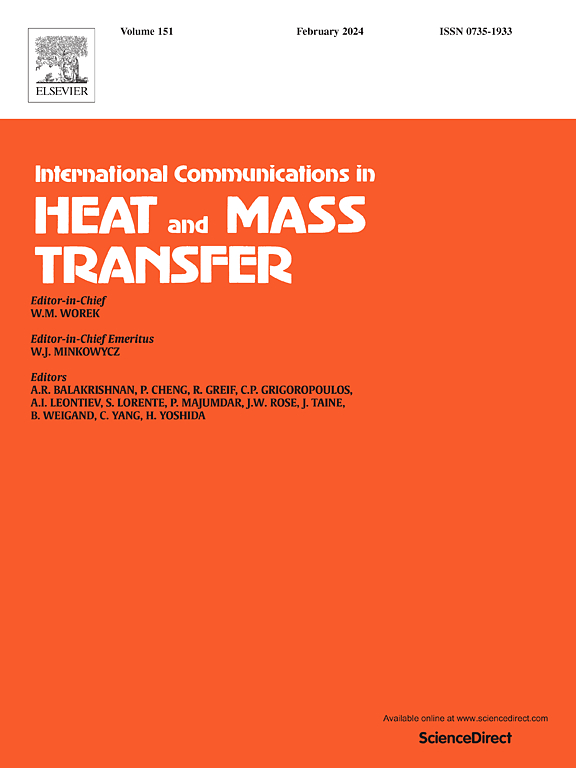煤在沼泽中自燃的发展和双向传播特性的实验研究
IF 6.4
2区 工程技术
Q1 MECHANICS
International Communications in Heat and Mass Transfer
Pub Date : 2024-11-11
DOI:10.1016/j.icheatmasstransfer.2024.108313
引用次数: 0
摘要
为有效控制煤炭在煤层中的自燃,本研究利用氧化动力学试验和模拟实验,研究了煤炭自燃在各种影响因素下的发展机理和双向传播特性。结果表明,煤火自持反向传播的临界漏风率为 16.4 m/h,明显低于正向传播所需的漏风率。因此,在煤层低漏风条件下,火势发展表现出明显的寻氧行为。在较大煤粒的反向火势蔓延过程中,会出现明显的双峰温度现象。上游火区的高温区经历了两个阶段:逆向传播和随风迁移。上游火区的发展对正向火势传播有很大影响。一旦上游火势达到一定程度,就会抑制甚至阻止火势的进一步蔓延。随着残煤粒径的减小,双峰温度现象逐渐消失,同时前向传播受到明显抑制。随着倾角的增大,向上的漏风方向明显加快了正向传播,在 45° 时,火锋的峰值速度达到 14.8 cm/h。同时,当倾角超过 15°时,反向火势传播受到抑制并停止。与此同时,火区的扩大呈非线性趋势,从最初的增大到减小再到增大,在倾角为 10°和 45°时,火区最大,风险最高。随着倾角的增加,向下的漏气方向会加速逆向传播,同时抑制正向蔓延。在火灾初期(0-6 小时),倾斜角度越大,火势蔓延速度越快。然而,在中后期阶段,火区在较低倾角条件下的扩展范围更大。本文章由计算机程序翻译,如有差异,请以英文原文为准。
Experimental study on the development and bidirectional propagation characteristics of spontaneous coal combustion in goaf
To effectively control the spontaneous combustion of coal in goaf, this study investigates the developmental mechanisms and bidirectional propagation characteristics of spontaneous coal fires under various influencing factors using oxidation kinetics tests and simulation experiments. The results show that the critical air leakage rate for self-sustained reverse propagation of coal fire is 16.4 m/h, significantly lower than that required for forward propagation. Consequently, under low air leakage conditions in the goaf, fire development exhibits distinct oxygen-seeking behavior. A distinct double-peak temperature phenomenon appears during reverse fire propagation for larger coal particle sizes. The high-temperature zone in the upstream fire area experiences two phases: reverse propagation and wind-following migration. The development of the upstream fire zone significantly affects forward fire propagation. Once the upstream fire reaches a certain extent, it suppresses or even halts further spread. As the particle size of residual coal decreases, the double-peak temperature phenomenon gradually disappears, while forward propagation is significantly inhibited. Upward air leakage direction with increased Inclination significantly accelerates forward propagation, with the fire front reaching a peak rate of 14.8 cm/h at 45°. Meanwhile, reverse fire propagation is suppressed and ceases when the Inclination exceeds 15°. Simultaneously, the fire zone expansion follows a non-linear trend, initially increasing, then decreasing, and rising again, with the largest fire zone and highest risk occurring at inclination angles of 10° and 45°. Downward air leakage direction with increased Inclination accelerates reverse propagation while inhibiting forward spread. The fire expansion rate is faster at steeper angles in the early fire stages(0-6 h). However, in the mid-to-late stages, the fire zone expands more extensively under lower inclination conditions.
求助全文
通过发布文献求助,成功后即可免费获取论文全文。
去求助
来源期刊
CiteScore
11.00
自引率
10.00%
发文量
648
审稿时长
32 days
期刊介绍:
International Communications in Heat and Mass Transfer serves as a world forum for the rapid dissemination of new ideas, new measurement techniques, preliminary findings of ongoing investigations, discussions, and criticisms in the field of heat and mass transfer. Two types of manuscript will be considered for publication: communications (short reports of new work or discussions of work which has already been published) and summaries (abstracts of reports, theses or manuscripts which are too long for publication in full). Together with its companion publication, International Journal of Heat and Mass Transfer, with which it shares the same Board of Editors, this journal is read by research workers and engineers throughout the world.

 求助内容:
求助内容: 应助结果提醒方式:
应助结果提醒方式:


